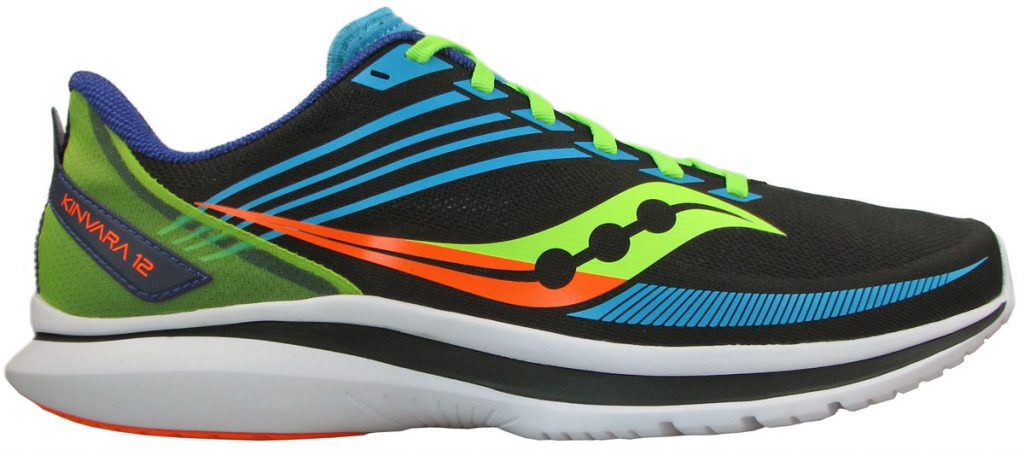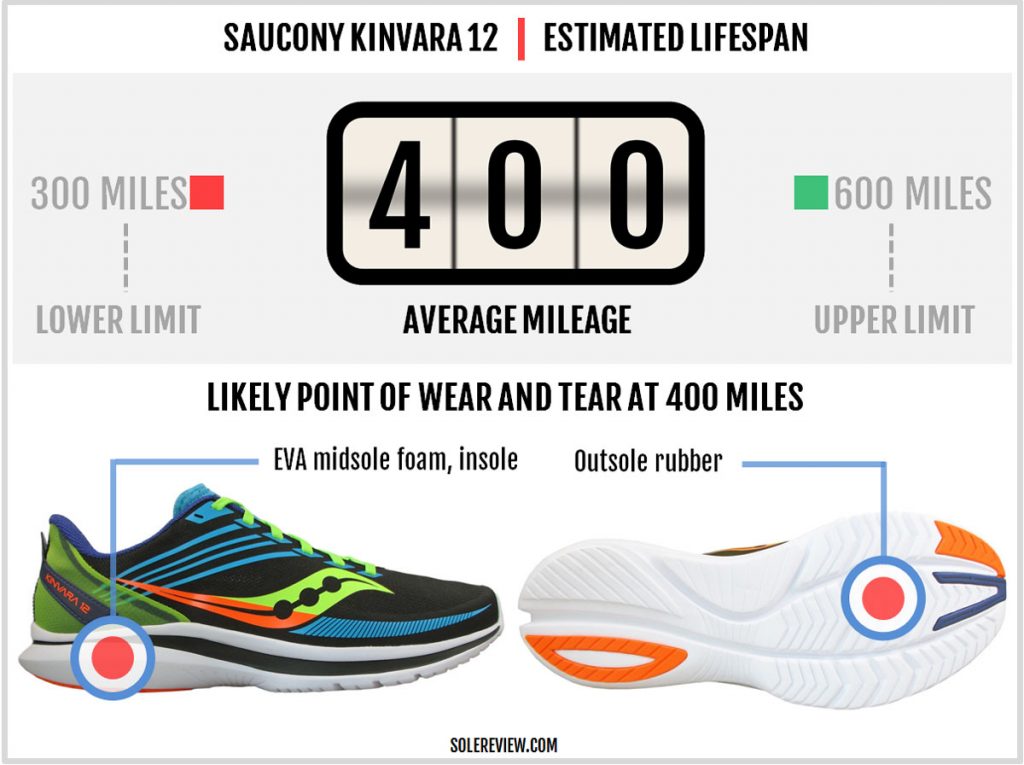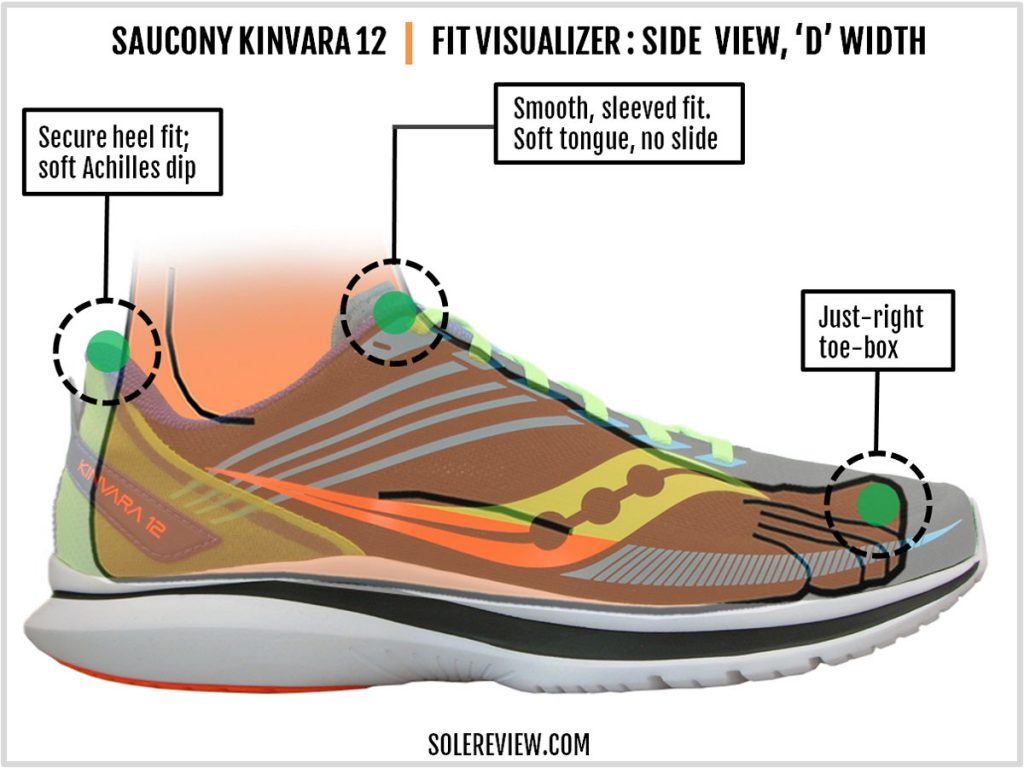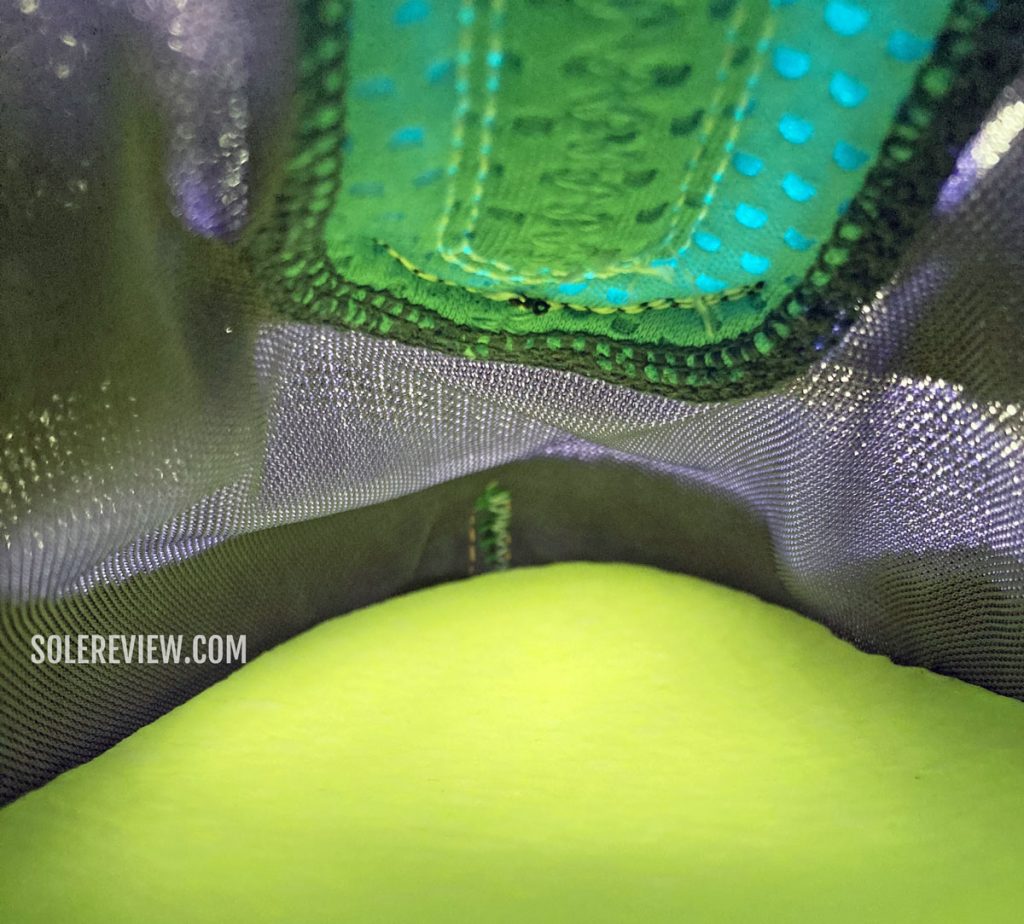The Saucony Kinvara 12 was purchased at full retail price for this review.
INTRODUCTION
Ok, ok. When we reviewed the Kinvara 10 two years ago, we said it was one of the nicest versions in recent times.
But the Kinvara 12 is an even better shoe, and easily the best version we’ve reviewed since the Kinvara 3.
Here’s a brief background on why the Kinvara 12 deserves such high praise.
In the Kinvara 10 review, we also said that while the shoe was excellent, it wasn’t true to the minimalist ideal of the original Kinvara. The Kinvara 11 also wasn’t all that different, so we skipped reviewing it.
Both the K-10 and K-11 were soft running shoes with a plush upper. They may have been a welcome respite from the over-engineered Kinvara models that came before them, but they deviated (slightly) from the minimalist 4 mm drop trainer template.
After all, that form factor was what made the first few Kinvaras commercially successful.
The good news is that the newest Kinvara is the closest it’s even been to the minimalist goodness of the early models; it’s a contemporary take on the low-offset, minimalist trainer concept made popular by Saucony.
And it’s lovely. Though the upper has been stripped of most superfluous layering, foam, and trims, it’s extremely comfortable and accommodating. The 4 mm drop midsole feels fast when needed, and comfortable enough for slow and/or high-mileage runs.
The Kinvara is back.
THE SAUCONY KINVARA 12 vs. KINVARA 11
Discounting the functional and styling differences, here’s an easy way to view the Kinvara 12 when comparing it to the 10 and 11.
The V12 is a leaner and minimal version of the last two Kinvaras; it’s almost as if the K-10 and 11 spent some time on a calorie-restricted diet and lost a lot of flab in the process.
This observation applies to both the fit and ride character. What the K-12’s upper does very well is to deliver a lightweight upper fit experience while retaining the comfortable softness of the K-10 and 11.
The interiors are smoother due to the full sleeve that previously wasn’t a part of the standard equipment. The tongue loses its plump foam padding, and so does the heel. These changes take place without having a reduction in fit comfort.
The introduction of a deep transition channel, flared sidewalls, and tighter forefoot outsole lugs help the new Kinvara’s case as a speed-friendly trainer. These features were missing on the older versions, so these additions improve the overall ride quality.
While the pricing is identical, the new model is 0.3 Oz (20 grams) lighter than before.
THE RIDE EXPERIENCE

There’s an E-TPU (Pwrrun+) ‘topsole’ inside the shoe. Why doesn’t Saucony advertise it on the Kinvara and many others?
Running shoe brands behave strangely at times.
Remember the time when Saucony touted a useless cushioning technology called the Pwrgrid+, and we called BS on it? This one-off midsole tech was used on the Triumph ISO used seven years ago.
But of late, Saucony fails to call out a functional cushioning technology that exists in many of their current models, the Kinvara 12 included. This is weird because it’s a lost marketing opportunity.
We speak of the Pwrrun+ ‘Topsole’ – a sheet of E-TPU foam that exists between the midsole and insole.
Before Saucony’s expanded Polyurethane foam was called Pwrrun+, it existed in the form of ‘Everun’. Back then, Saucony would diligently advertise the Topsole as part of the feature set, because it did play an important role in the cushioning delivery.
When combined with the removable insole, the resilient e-TPU sheet achieves two things.
It creates a comfortable layer of step-in softness, while adding responsiveness to the otherwise flat ride quality of the EVA midsole.
Over the last couple of years, the Topsole has played a silent yet important role in shoes like Ride, Guide, and Kinvara. So it’s strange why Saucony keeps mum about the topsole.
On the Kinvara 12, the Topsole adds some flavor to the otherwise flat ride character of the EVA-blend midsole that Saucony calls Pwrrun.
Sure, it feels like a superior version of a standard EVA foam, but ‘responsive’ would be over-selling it.
The supportive midsole does a great job at transitions and overall cushioning, but responsiveness (aka springy, bouncy) is not a trait one would associate with the Kinvara.
Only the Topsole adds a bit of pep to what is a standard EVA foam-based ride.
Having said that, when viewed as a three-layer composite, the overall midsole behavior is excellent.
The ground feedback, padding, and stability from the firm midsole are what make the Kinvara 12 great for speed training (in the pace vicinity of 4:30 min/km, 7 min/mile).
And it’s not just about the foam density; other intelligent design elements benefit various aspects of the ride quality.
Among those are the deep groove running down the (mostly) foam outsole and flared sidewalls.
The transition channel centers the weight during the gait cycle, regardless of a forefoot or rearfoot strike. The Kinvara 12’s 4 mm heel offset midsole (28.5 mm rear, 24.4 mm front) makes it universally compatible with all foot-strike patterns.

The midsole sidewalls have a wide flare – both under the heel and forefoot. That’s good news for the ride stability.
Both the groove and wide midsole add ride stability. The Kinvara’s midsole flares wide under the heel as well as the forefoot, thus creating a planted ride experience.
The flexible forefoot doesn’t impede the transitions. The relatively firm midsole foam means that the foot doesn’t have to struggle during the push-off phase.
The ground feedback is excellent, as the low stack heights promote efficient energy transfer to the road.

The primary midsole is single-density across, thus making the cushioning consistent from the rear to the front.
The tri-density midsole stack is uniform in its material composition from the heel to toe, so the gait cycle feels smooth and connected.
Though the outsole makes scarce use of rubber, the traction isn’t bad at all. We’d just avoid taking the Kinvara over slushy surfaces. Otherwise, its on-road traction is decent. There are no awkward gaps on the outsole, so the foot connects seamlessly during the gait cycle.
While the Kinvara 12 excels at faster paces, it also does remarkably well at easy cruising speeds. The Topsole and insole add a comfortable and high-quality layer of softness atop the midsole.
When you drop down to slower speeds of 6 min/km or 10 min/mile, the midsole doesn’t feel harsh at all – as it was on the retro models.
The way we see it, the expanded Polyurethane layer is one of the important reasons why the Kinvara 12 is different – and softer – when compared to the 2010-2013 Kinvaras.
Without the slightly softer midsole and e-TPU lasting below the insole, the Kinvara 12 would have felt similar to the V3 or V4.
The Kinvara 12’s chameleon-like ride character makes it very versatile. The low-profile midsole is always happy to work hard at higher speeds; at the same time, easy days are fun too.
The $110 price is a part of the appeal too.
With a shoe like the Kinvara 12, one could get away with just a two-shoe Saucony rotation. The Endorphin Speed 2 (no need to get the Pro) delivers lightweight cushioning in a speed and mileage-friendly ride – thanks to the PEBA foam core and Nylon plate.
And the Kinvara 12 could be the do-everything trainer. While not necessary, a third shoe could be the Saucony Ride 14 – a robust neutral trainer with use-case versatility.
Depending on the budget, one could also entertain the possibility of dropping serious cash on a shoe like the Nike Vaporfly Next%. Its high-volume PEBA (ZoomX) midsole and full-length Carbon plate is the ultimate expression of the plated racer concept.
Shoes like the Brooks Ghost 14 or Nike Pegasus 38 also work as softer substitutes for the Ride 14.
We recommend the two-shoe Saucony rotation though; it’s a lot of value for $260. Also consider buying the Endorphin V1 for cheap instead, because that’ll likely lower the total spend to under $200.
IS THE SAUCONY KINVARA 12 DURABLE?
The Kinvara 12 should easily last 400 miles. That has been our experience with the past Kinvara models; the foam outsole is more durable than it appears.
Even though the upper is lightweight, it’s a double-layered construction. Unlike the previous editions, the K-12’s upper has a full inner sleeve and not just a midfoot gusset.
The high-density printing and tighter mesh knit near the midsole edge also add structural reinforcement.
THE UPPER DESIGN AND FIT
A couple of functional differences sets the Kinvara 12’s minimalist upper apart from the vintage models. The first area concerns the interior space. The second part has to do with how the upper mesh feels over the foot.
The retro models had a plasticky upper and a narrow fit. The plasticky feel was the result of the Saucony ‘Flexfilm’ – a vintage version of what brands call high-density printing on the upper.
The narrowness of the older Kinvaras was on the account of the slim last – a fit profile that gave the original Kinvaras almost a road racer-like character.

The upper mesh is thin but not fragile. Look closely, and the lacing area has a denser knit – and so do the lower parts of the upper that’s near the midsole.
The upper materials have come a long way since. Modern meshes achieve a fine balance between a soft hand feel and abrasion resistance, so interior comfort doesn’t trade places with durability.
The mesh that’s closer to the midsole edge has a dense knit for support and structural reinforcement. Thin, printed overlays (and that includes the logos) streamline the exterior.
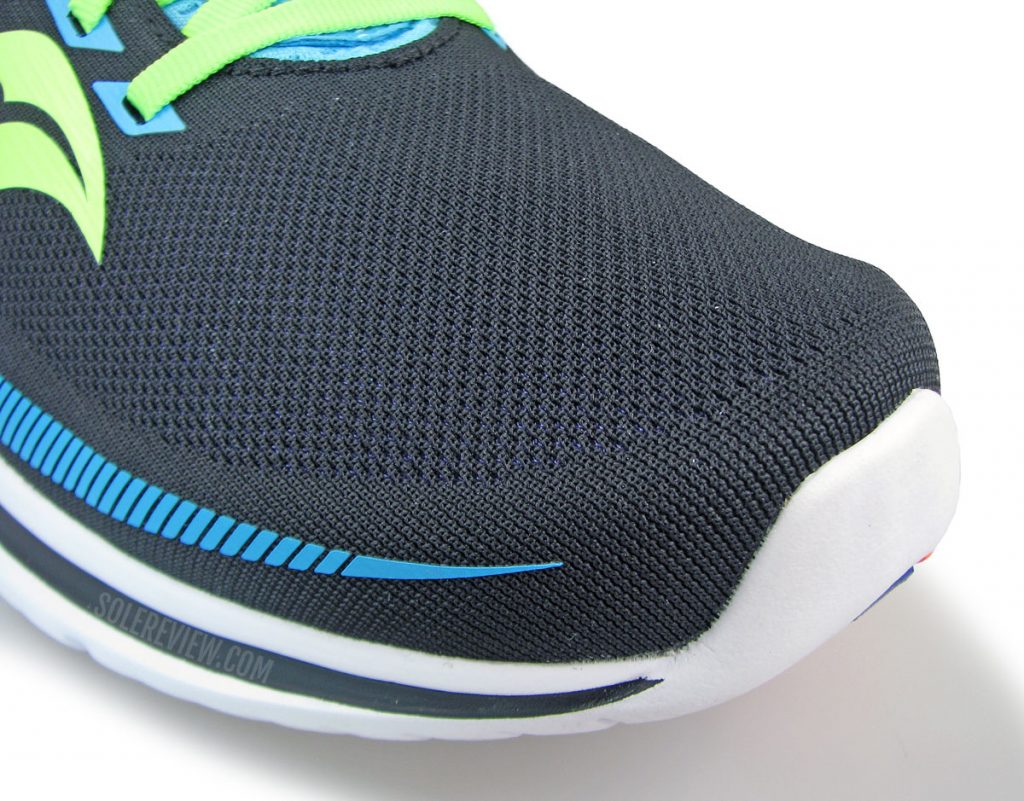
The upper mesh is soft. Note that the zone closer to the midsole has a tighter knit for structural reinforcement.
The Kinvara 12 uses soft materials inside an accommodating upper with plenty of room for the toes to splay wide.
Even though the Kinvara 10 and 11 were also spacious, the K-12’s upper is closer to the foot. There’s a good reason why the insides feel different.

Sir, this is not a gusset. It’s a full sleeve that acts as the secondary upper. Smooth, smooth, smooth.
This is the first time Saucony introduces a full sleeve, rather than a gusset seen on the previous editions. This major change brings the upper mesh closer to the foot, but that’s achieved without any compromise in interior space.
The toe-box has a broad profile, so the toes have ample space ahead and above. Though the Kinvara 12 also sells in an optional 2E, the standard width should fit a large population of runners. As far as the stick length is concerned, the Kinvara fits true to size.
The thin and soft stocking-like material makes the fit smooth without eating into space. Its thinness makes it disappear inside the upper, so much so that you have to double-check whether it’s a full-length sleeve or merely a gusset.
This is a clever design achievement, because many fully-sleeved Brooks and Nike running shoes end up with a narrow fit.
It’s surprisingly un-warm for a sleeved shoe. While the 12 isn’t as breathable as the 10 or 11, it doesn’t feel stuffy either. And mind you, we tested this shoe during peak summer.
One of the things that we love about this shoe is the generous attention to detail for its $110 retail price.
Besides the midsole extras like the Topsole, the upper is full of thoughtful design touches that enhance both the fit and cosmetics.
There’s a difference between an optimally engineered and over-engineered design; the Kinvara is the former, and the Freedom 4 is the latter.
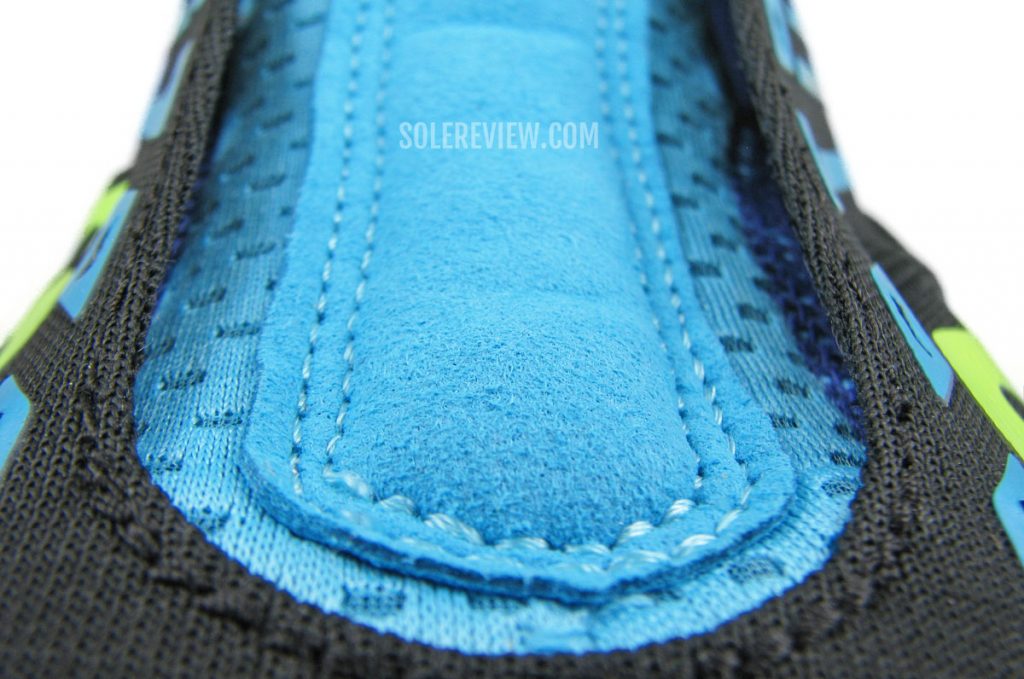
The soft Suede panel is padded underneath, and does a stellar job of dissipating the lacing pressure.
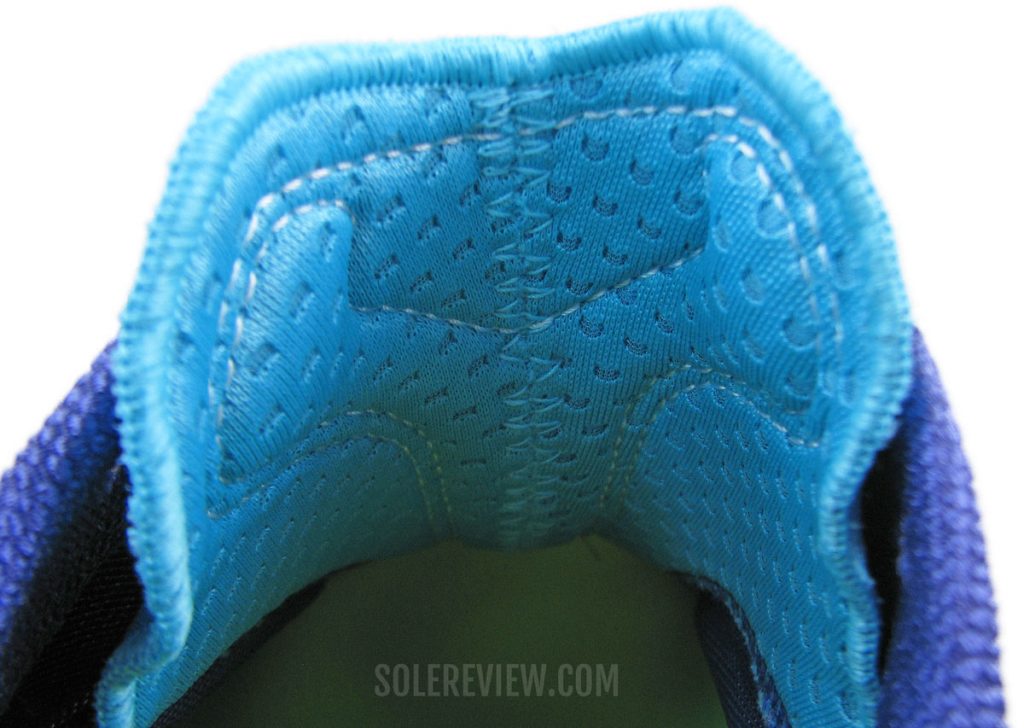
The flap has a notch so that it doesn’t pressure against the instep of the foot. The tongue foam quilting is minimal, but it works. Less is more.
Take the tongue design. At first glance, it doesn’t contain a lot of padding.
However, it does an excellent job of filtering the cinching pressure from the flat and semi-elastic laces. Saucony uses a soft synthetic suede overlay on the top that’s also foam-quilted.

The flap is flat-locked with a soft thread for a higher level of comfort. No pesky folded edges here.
The flap is wing-shaped to alleviate pressure on the instep, and the edges use three-thread flat-lock stitching instead of folding. This vastly increases the over-the-foot comfort.
The tongue is long enough to accommodate the use of a runner’s loop (last eyelet). And there’s no slide, of course.
Within the heel is a stiff counter with a low height. This allows the Achilles dip to be soft and gentle without negatively affecting the grip.
Among the other trims, there’s a faux pull tab and reflective detail on the heel.
The bi-color mesh panel with a ripstop-like texture doesn’t have any functional value, but it makes the Kinvara look cool; that’s a good enough reason for them to exist.
PROS AND CONS
Repeating all the good stuff about the Kinvara won’t add value to this section, so please refer to the infographic for a summary of performance benefits.
As to the flaws, are there any at all? Our wish-list would be a higher level of reflectivity and a more aggressive outsole bite; that’s about it.
THE SAUCONY KINVARA 12 VS FREEDOM 4
Sometimes even a superior midsole tech doesn’t give a shoe an advantage over a lower-priced model, and the Freedom 4 is a case in point.
As both shoes have a 4 mm heel-to-toe offset and nearly identical stack height, the Freedom is often thought of as the unofficial Kinvara upgrade.
In exchange for the higher retail price, the more expensive Freedom offered a superior midsole foam along with a higher level of outsole durability. Until the Freedom 3, the midsole was comprised of the heavier e-TPU variant.
The circumstances have changed now, and the Freedom 4 weighs nearly identical to the Kinvara due to the lighter Pwrrun PB foam. Based on paper specs alone, the Freedom should be a better shoe.
However, things are never that simple.
While the PEBA-based midsole is softer and bouncier than the Kinvara, the upper feels overbuilt – a lot more so than the Freedom 3. Because of the overlays, the forefoot mesh isn’t as pliable.
The toe-box and lacing panel have synthetic suede overlays – something that the prior versions lacked. The tongue also gets a gratuitous suede layering on its flap.
To sum up, the Freedom 4’s ride is great, but the upper feels stuffy. Now if the Freedom had a Kinvara-like upper – now that would be an interesting product.
SHOES SIMILAR TO THE SAUCONY KINVARA 12
The New Balance Fresh Foam Tempo has been a historical competitor to the Kinvara. Well, not the Tempo exactly, but the Zante. However, those two New Balance shoes are nearly identical to one other from a functional lens.
Just like the Kinvara, the NB Tempo has a low-profile midsole that’s amenable to speed runs and comfortable enough up to half-marathon distances. The soft upper has a minimal design and snug fit.
For a higher level of ride comfort, there’s the Fresh Foam Beacon V3. Despite the thicker midsole, it’s a good fit for quick-paced outings.
If it weren’t for the 10 mm heel-to-toe offset, the SL20 would have been adidas’s answer to the Kinvara. Despite the difference in midsole architecture, the shoe is designed with similar intentions. The SL20 is a cushioned and lightweight shoe for speed training that’s fitted with a lightweight textile upper.
The Brooks Launch 8 is another pace-friendly shoe with a 10 mm heel-to-toe drop; we reviewed it recently.
The $100 Asics Dynablast 2 is also similar to the Launch in several aspects. It’s priced the same and delivers its 8 mm offset through a single-density EVA foam midsole.
Finally, runners who want a much softer ride than the Kinvara may want to give the New Balance Fuelcell Rebel 2 a try – it’s a fun shoe that’s also up for speed workouts.
Do you own this shoe? Improve this review by sharing your insights – submit a review here.


